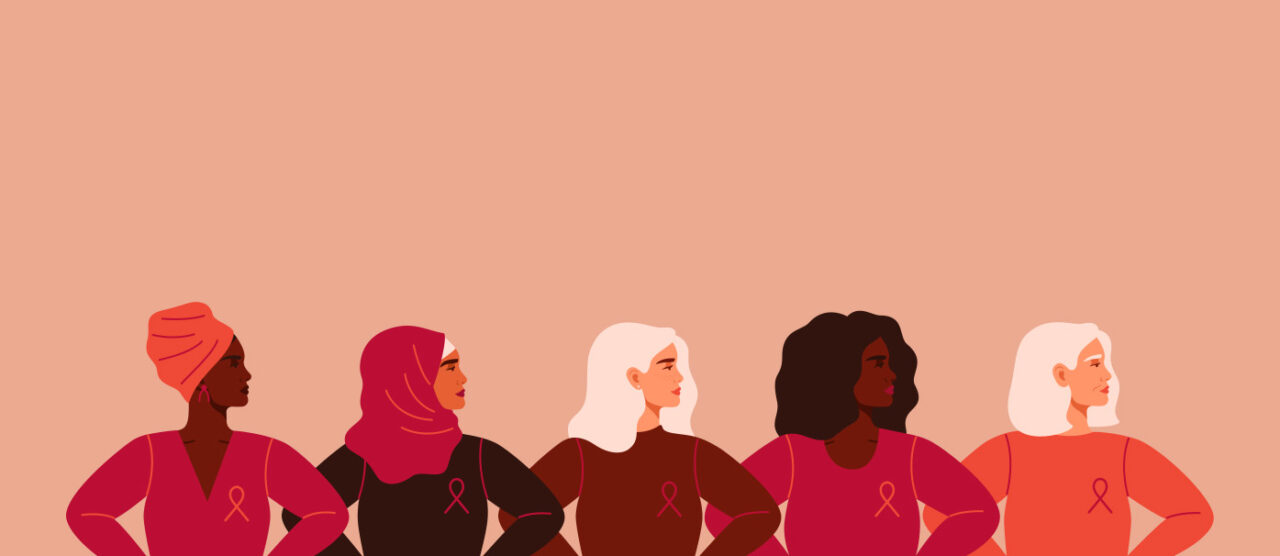Breast cancer is the second most common type of cancer among American women, behind skin cancer. In fact, nearly 1 in 8 women will develop breast cancer during their lives—the disease can also affect men, although it is considered rare.
October is Breast Cancer Awareness Month, meaning now is when you should learn about this life-threatening disease, its risk factors, and symptoms. While most breast cancer cases are found among women ages 50 and older, the disease can develop as young as age 28. Risk factors for breast cancer include age, family history and prior radiation therapy treatment. Symptoms of breast cancer include changes in breast sizes or shapes, breast pain and breast lumps.
Note, these lists are non exhaustive. Your doctor will be able to tell you more about risk factors and ways to detect breast cancer, including how to conduct a breast self-exam and various types of mammogram options. If you are female, age appropriate or have a family risk history, be sure to schedule your preventative mammogram today! Your doctor can also tell you whether routine breast cancer screenings are right for you and which ones your insurance covers at 100%.
This month our Take Action Weeks include:
- Take Charge of Breast Health
- Women’s Health: Mammograms
- Top Reasons to Get Your Mammogram
- Know the Symptoms
- Breast Health Guide
Take Charge of Breast Health
Breast exams are extremely useful in detecting cancer early. Clinical exams, breast self-exams (BSEs) and mammograms shouldbe completed regularly so that it is possible to determine if there are changes in breast tissue, indicating breast cancer or other potentially harmful conditions.
Clinical Exams and Mammograms
The American Cancer Society recommends women between 40 to 44 have the option to start screening with a mammogram every year. Women 45 to 54 should get a mammogram annually.
Performing Self-exams
In between clinical exams and mammograms, women should complete BSEs to become familiar with the look and feel of their breasts when healthy, so that changes can be detected as early as possible.
- Lie down and place one arm behind your head.
- Use the pads of your middle three fingers on the opposite hand to check your breast tissue in overlapping, dime-sized circular motions.
- Use an up-and-down pattern starting at your underarm and moving all the way to the middle of your breastbone to feel for changes.
- Standing with your hands on your hips, look in a mirror for changes in size, shape, contour or coloring of your breasts.
Breast Tissue Changes
Contact your doctor if you notice any of the following changes to your breast or nipple tissue while doing a BSE:
- Lumps
- Dimpling, red or scaly skin
- Nipple discharge or pain
It is normal for breast tissue to change during menstrual cycles, pregnancy, menopause, or while taking birth control pills or other hormone therapy. However, if you notice changes at other times in your life, it is strongly suggested that you visit a doctor immediately.
More in-depth information on how to perform a BSE is available at ww5.komen.org. This website also provides a Breast Self-Awareness Interactive Tool that you can view. Or, check out this diagram on www.breastcancer.org, which illustrates how to perform a thorough self-exam.
Women’s Health: Mammograms
Mammography is the best available method to detect breast cancer in its earliest stage, which is approximately one to three years before a woman can feel a lump.
Get the Facts
Mammography is a specific type of imaging that uses a low-dose X-ray system for examination of the breasts. It allows a radiologist to identify differences between a normal breast and one that may show signs of cancer.
What to Expect
- During a mammogram, you can expect the following:
- You will be required to undress above the waist. The facility will provide a wrap for you to wear.
- A technologist will be present to position your breasts for the mammogram. You and the technologist will be the only persons present during the mammogram. Most technologists are women.
- The entire procedure takes about 20 minutes. The actual breast compression only lasts a few seconds.
- You may feel some discomfort when your breasts are compressed, but you should not feel pain.
When to Get One
Women in their 20s and 30s should have a clinical breast examination as part of a periodic health exam by a medical professional every three years. After age 40, women should have a breast exam by a health professional every year. The U.S. Preventative Services Task Force recommends that women ages 50 to 74 should get a mammogram every two years.
The risk of getting breast cancer increases with age, so as long as a woman is in good health, she should continue getting routine mammograms. Young women at high risk for breast cancer should discuss with their doctors if earlier screenings are necessary.
Questions to Ask
- The following are suggestions for ensuring you will receive a quality mammogram:
- Ask to see the FDA certificate issued to all facilities that meet high professional standards of safety and quality.
- Use a facility that either specializes in mammography or performs mammograms often.
- Bring a list of the places, dates of mammograms, biopsies, or other breast treatments you may have had before.







